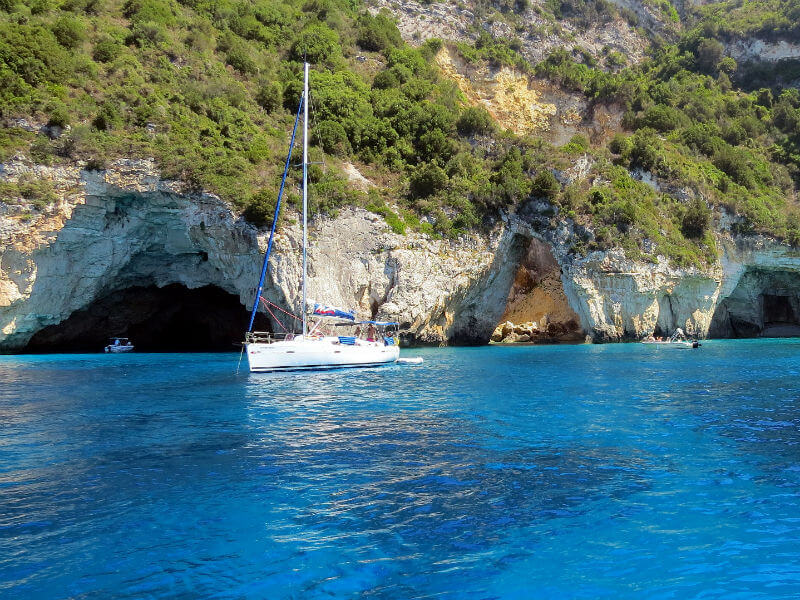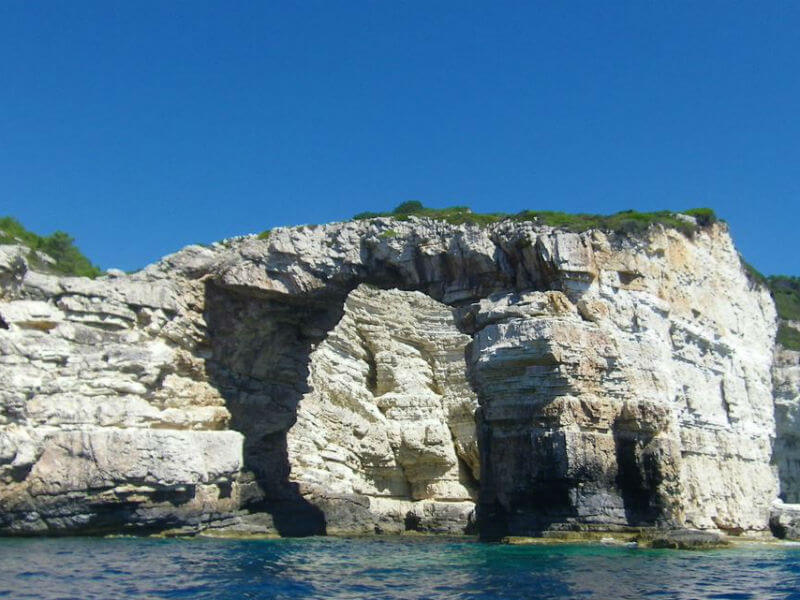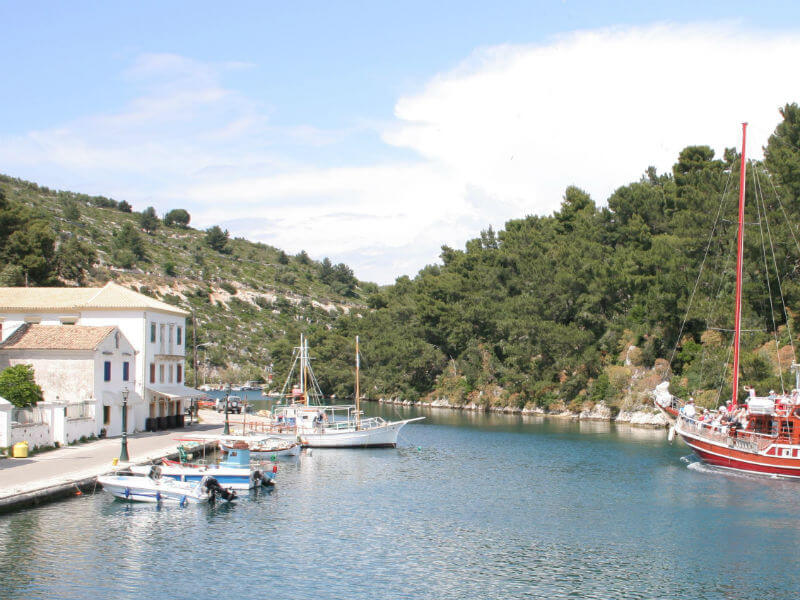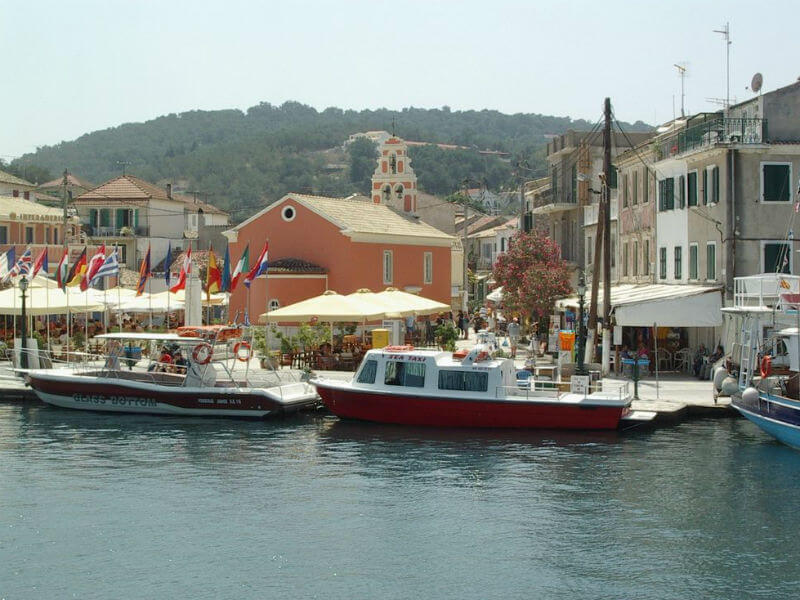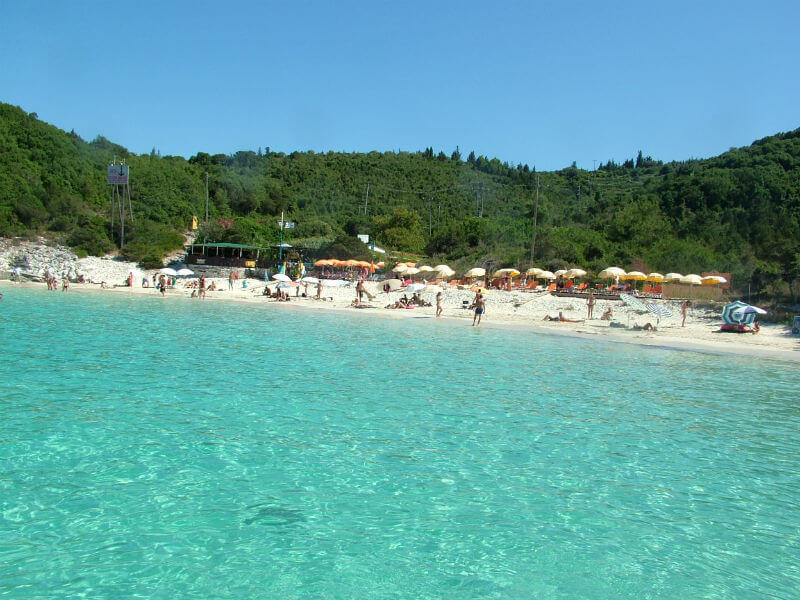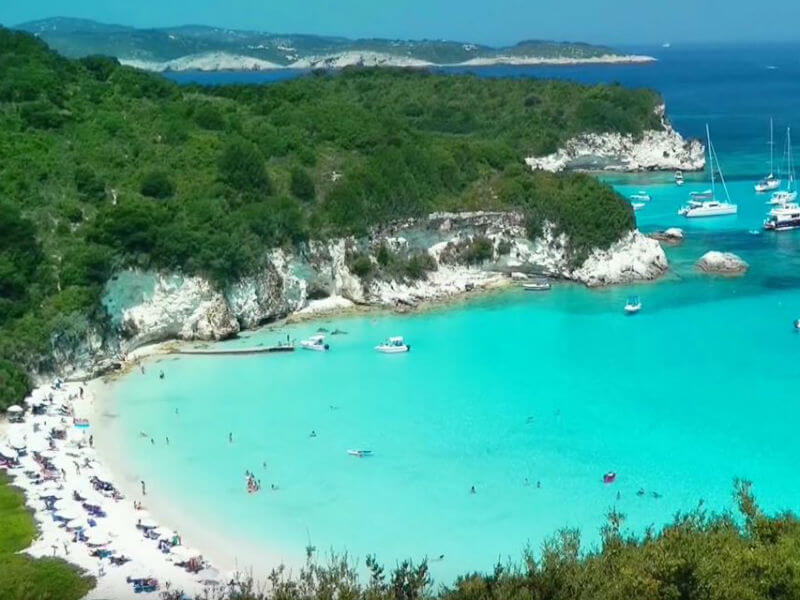Paxos Antipaxos
Paxos & Antipaxos holidays
The beautiful and green islands are a small paradise in the turquoise waters of the Ionian Sea and one of the most popular summer destinations in Greece. In recent years tourism has been a key factor in the island’s economy. The inhabitants also deal with fishing and agriculture as there are several olive groves (Paxos) and vineyards (Antipaxos). Full of olives, pines, cypresses and shrubs, with splendid beaches, picturesque bays, enchanting sea caves, Paxos has settlements with samples of genuine Ionian architecture.
Paxos Antipaxos at a glance
With its capital, the picturesque Gaios, naturally protected by two islets, Panagia and Agios Nikolaos, impresses Greeks and Foreigners, and is designated by the Greek government as a “landscape of particular aesthetic beauty”. In Gaios, there are also four churches, the church of the Ascension, Agioi Anargyroi, Agia Triada and the temple of the Holy Apostles, which is said to be the tomb of St. Gaios.
Choose Lakka and Loggos for your stay and fun or for swimming in the turquoise waters of the Ionian Sea. Lakka is famous for its sailing club and for the beautiful beaches Monodendri and Harami.
If you want a quiet and quality vacation, then you are on the right island. You will not meet crowds on the island and this is something that makes it special. Summer is undoubtedly the best time to visit Paxos.
Paxos is one of the most popular islands, especially in neighboring Italy. The royal couple, Charles and Camila, Madonna, Demy Moore, famous Agnelli family (owner of the Fiat auto industry) are some of the celebrities who have visited Paxos.
Food & Beverages
Like all the Ionian islands, Paxos and Antipaxos, thanks to their climate, have a large production of excellent quality agricultural products: olive oil, citrus, thyme honey, grapes and excellent quality wines.
Gaios town
Gaios is the capital of the island of Paxos. Gaios is a natural channel that looks like a small fjord. It is a very picturesque town with a very beautiful Venetian square, harbor, cafes and taverns. The best and closest beach in Gaios is Mogonissi, which is a small island connected with Paxos with stones. To visit it, you can walk through the stones and reach the best sandy beach on the island.
Mithology
According to Greek mythology, the small island of Paxos and the nearby island of Antipaxos were formed when Neptune threw its trident on Corfu in order to detach a piece of it and make a beautiful peaceful island away from the Gods and people to live with Amphitrite, sea goddess.
Antipaxos
Thirteen minutes by speedboat from Gaios, Antipaxi is a tiny island of 3 square kilometers with blue waters, many vineyards and two wonderful beaches worth to see. Permanent residents are few but very hospitable. Vouthoum and Vrika have been included in tributes to Europe’s most beautiful “hidden” beaches, not unfairly. Meet them and enjoy unbelievable dives that will take you to exotic destinations. Despite its small size, its lacy coastline hides many small marvelous beaches. sea caves, cellars, coves and cliffs, make up a truly majestic seascape.
Ferry tickets and route information for Antipaxos can be found in Paxos port.
History
Although we know little about Paxos from antiquity, the sure thing is that its name has been preserved since then. According to historical sources, in 229 BC, the Corfiots were defeated in the naval battle by the Illyrians of Queen Teetas.
Then Corfu, with the island complex of Paxos – Antipaxos passed into the influence of the Romans. In the centuries ahead, Paxos followed the fate of Corfu. Since the 13th century, Paxos has been in the hands of D’Anzou and since 1386 under the Venetian rule. During the Venetian domination, which lasted until the end of the 18th century, Paxos and Antipaxos were often threatened by pirates, which in 1423 led Baroness Adam the Second of San Hippolytus to seek permission from Venice to build two castles, one in the Bay of Gaios, on the island of Agios Nikolaos and the other one in Lakka.
The Venetians were also those who intensified the cultivation of the olives. In the middle of the 15th century, Paxians fought against the Ottomans, who besieged the opposite mainland towns of Boutroto and Parga. In retaliation, the Ottomans pillaged the island without locating the inhabitants who had resorted to caves where they were rebuilt and from where they started guerrilla warfare, which eventually forced the Ottomans to withdraw from the island. In 1797 the French replaced the Venetians, who successively replaced the Russians and Ottomans until 1801 when the autonomous state of the seven United islands was founded, which was also the first form of pure Greek state since antiquity. Paxos together with the Antipaxss had an independent presence in the Commonwealth and their own emblem. In 1807 the State was abolished by Napoleon, but the French rule would not last long since in 1814 the British forces led by the Greek Major Theodoros Kolokotronis occupied the island by adding it to the United Kingdom. During the revolution, one of the rebellious heroes of the island was the burglar and fireman George Anemogiannis, who lost his life at the age of 23 in Nafpaktos. Finally, after the founding of the Greek state, the Paxians supported together with the other Ionian Islands the union which finally came to in 1864.
Paxos etymology
According to Strabo, the name comes from the Phoenician word “pax”, which means a geometric “trapezium”, an island with a trapezoidal shape, as seen from the sea. According to another version, expatriate residents of Sicilian Paxoudas settled and gave the name to Paxos. The Metropolitan of Paramythia Athenagoras justifies the name Paxos from the plaques that came to Paxos and was exported. Composition of the word Pax = plate and ae or ae = island, give us the name of the plate island. Andreas Moustoxidis, historian, philologist and archaeologist (Corfu 1785-1869), considers that the name of the islands is derived from the epithelium pactos (Doric type of the gulp).
What will you see
- Built in 1423, Venetian castle on the island of Agios Nikolaos, in the Bay of Gaios.
- The Paxos Museum, in Gaios, is placed in a beautiful neoclassical building and houses findings from the prehistoric and classical times up to the Second World War as well as the Ionian Parliament’s resolution on the annexation of the Ionian Islands to the Greek state in 1864.
- Ozia, the oldest settlement on the island, with the Early Christian basilica of St. Stephen.
- The stone lighthouse of Lakka, dating back to 1832, at a height of 36 meters.
- Ypapanti, the cave under the village of Vassilatika, in which the submarine Papanikolis was sheltered during the Second World War.
- Hot springs – a natural spa in Ozia, Gianna and Glyfada.
- The sunset from the Holy Apostles, in Magazia, overlooking the vertical rocks of the Hermit, changing color as the sun dives in the Adriatic.
- The sunset (again) from Ostria, in the village of Bogdanatica.
Caves
Ypapanti, Blue Cave, Ortholithos, Trypitos.
Beaches
The beaches are small in size and have crystal clear waters. Gianna, Sulanena, Bali, Aghia Marina, Mangonisi, Kloni, Gouli, Kaminis, Kali Lagada, Salti, Kipiadi, Marmari, Levrechio, Glyfada, Monodendri, Bears, Orkos, Kanoni, Haram, Achai, Avlaki, time by visitors. In Antipaxos there are the blue-green beaches of Vrika and Voutomi, Rodovani and Sarakiniko.
The most famous and interesting are Kakia Lagada, Kipiada, Glyfada, Lebrechio, Garden and Marmari. Of course, do not miss the organized beach of Monodendri.
What to eat - What to try
Paxos’ sweet wine is what you should definitely try. It’s great and its little production makes it hard to find and mysterious. As far as the gastronomy of the island is concerned, it is quite similar to Corfu. Pastitsada, bourdeto, sofrito and savoiro are some of the main dishes of Paxos. Also try beans, artichokes and oil.
Places to be
Maps & Location
The Paxos island is located in the Ionian sea, south of Corfu island.
The island is approximately 13 km in length and has a population of around 2400.
You can not stay in Antipaxos. Your stay will necessarily be on Paxos island. There you will definitely find a good accommodation to stay from a hostel, hotel or even a villa.
Lakka is the second largest resort and the northernmost port of Paxos, about 8 kilometers from Gaios. The settlement is built in the depth of a closed, sheltered bay and is a very popular harbor for those who visit Paxos by boat. Dense vegetation reaches to the edge of the sea and in combination with the crystal clear aquamarine waters create beautiful images. Near to Lakka are the beaches of Monodendri and Haramis as well as some amazing caves, worth seeing. In Lakka you will find picturesque taverns that are famous for their fine cuisine and also several rooms to rent.
Loggos is a small picturesque fishing village on the eastern coast of Paxos. Around the harbor there are several taverns and bars creating a very pleasant place to sit at all hours of the day. Taverns are very popular with locals and tourists, and during the high season there are many people. Near Loggos is the Lebrechio beach that is ideal for diving and the organized Monodendri beach.
How To Get To Paxos
Getting to Paxos and General Travel Information
Flight Information
Ferry Services
You arrive mainly by boat as there is no airport on the island. There is a connection with Igoumenitsa and Corfu. so if you find it convenient for you, it will take hours.Of course, you can also get cruise boats from Parga.
Speedboat – If you are in Corfu you can reach the island with a dolphin.
By car
If you want to reach Paxos by road, it will be via Igoumenitsa. Although the island is not large, a car is needed because there is no good local transport.
By Bus
There is a line to and from Athens, so you can get around by bus.
Paxos Walks
Paxos may not be so very big as islands go but there are loads of tracks, paths and trails available for walking, certainly enough to ensure you do not run out of something new over a couple of weeks. On top of that, the countryside is excellent with the bonus of loads of old sterna’s, presses and ruined/semi-ruined churches to explore.
a brief round the island tour of some of Paxos's places of interest
Loggos
This tiny harbor village has become the most salubrious resort on the island. With its tiny collection of houses, bars, and tavernas straddling the moles and harbourside, it is undeniably very attractive. Loggos is home to the island’s olive wood-fired bakery and overall, a quintessentially Greek village.
Lakka
This attractive harbor village is the second largest on the island. Very popular with the yachting crowd who are drawn into the aquamarine waters of the horseshoe bay.
Gaios
Gaios is the bustling hub at the center of the island. It’s a picturesque harbor, with cafes and tavernas along the water’s edge is a great place to sit and watch the flotillas of yachts as they come in for the evening. The Venetian stone-flagged square lies at the center of the tiny capital of Paxos.
Fontana
This tiny village, just inland from Loggos, has little more than a couple of shops and tavernas. Fontana does make an interesting change from the rather more salubrious harbor villages so popular with tourists. It feels a little like time has stood still here for a hundred years or so and gives a good glimpse into Paxiot life.
Anti-Paxos
Attractive tiny islet off the south coast of Paxos. This is where much of the wine you will find of Paxos comes from and the islet is almost covered with grapevines. There are a couple of pebbly coves, which are not great for sunbathing but can prove quite rewarding to the snorkeller.

